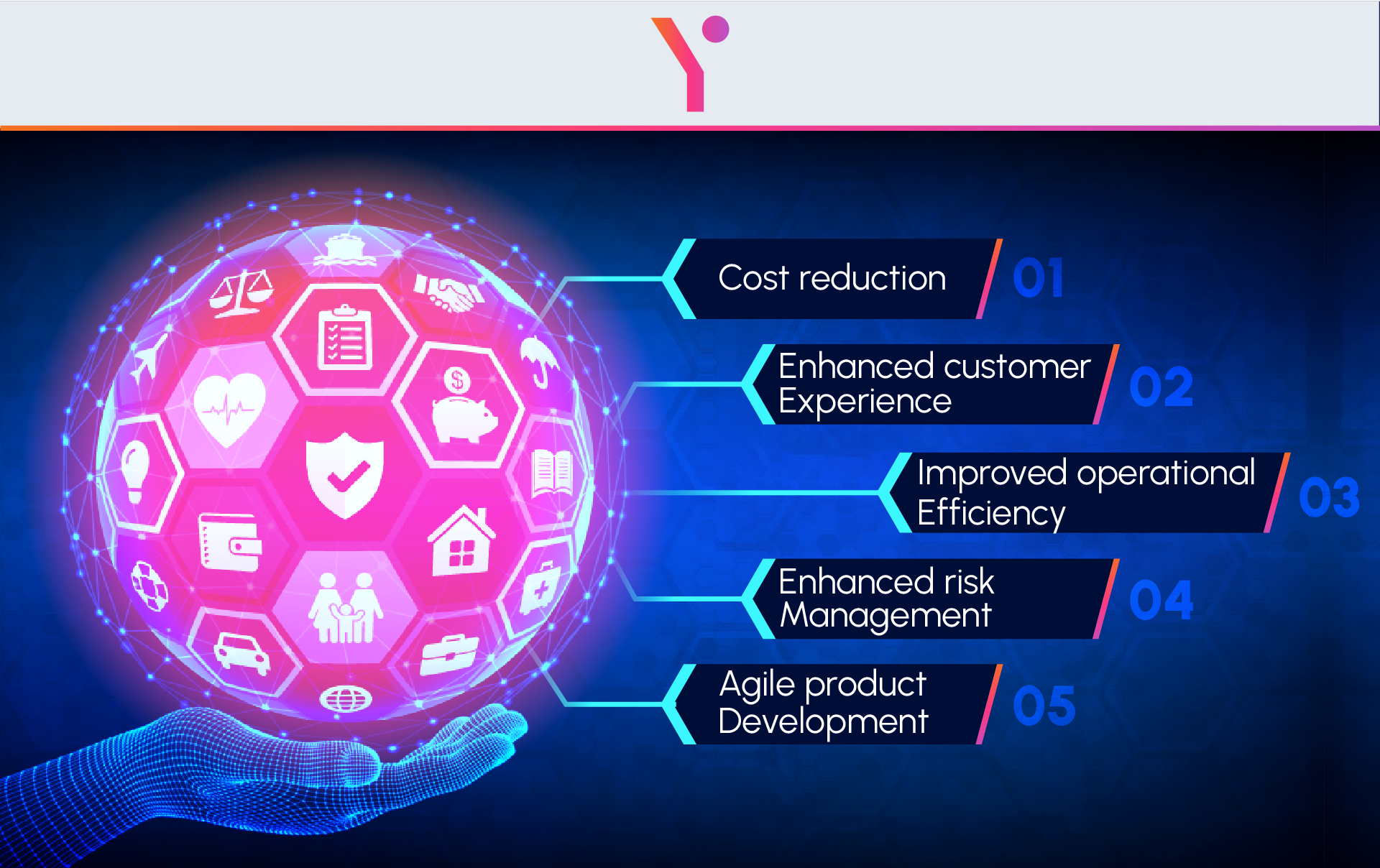Introduction
Digital transformation is taking the insurance industry by storm. However, there are some pressing challenges that need to be addressed, as highlighted here.
It is a common observation that the insurance industry is an immensely regulated sector that protects individual policyholders and businesses from liabilities to their health, homes, and assets. When we combine this special positioning with digital transformation in insurance industry, this goes on to create a host of challenges for the industry.
As you will see in this blog, there is a mention of some of the most pressive challenges that are faced by today’s insurance industry. These challenges often rake up the digital transformation vs innovation debate. But there is more to this blog. You will also find solutions for insurance providers, which could let them overcome any massive barrier that they may encounter in the way of success.
On a side note, when you are done with this blog, perhaps you would want to take a look at a host of related concepts, such as cross-platform mobile app development, react native services, or Progressive Web & App development services.
Perhaps it would be better for your organisation to contact a custom web development company for its web development services.

Key Challenges Associated with Digital Transformation In Insurance Industry
These are some of the biggest challenges that insurance providers face:
Core Legacy Systems and Transformation
The insurance industry has come across challenges in adopting and adapting to rapid technology advancements. Digital transformation has altered the manner in which insurance providers operate internally, offer services to customers, and model their businesses.
Some of the enterprise software and new technology examples that insurance providers should integrate into their workflows and infrastructure include:
- Underwriting Systems
- Life Insurance Policy Administration Systems
- Policyholder Portals
- Claims Management Systems
Underwriting Challenges and Risk Assessment
Premiums and insurance policies are determined by underwriting and risk. These dynamic and complex factors demand innovative solutions and careful analysis whenever issues surface. Whether it is the ever-changing regulation, cybersecurity threats, data quality issues, adaptation of automated underwriting processes, and underwriter end-user errors, it is important for insurance organisations to be agile. This ensures the quality of assessments and accuracy.
Upskilling Workforce with Digital Skills
Today’s economies, risks, and technologies are going through drastic changes. This has made insurance agents and other workforce require guidance, digital upskilling, and support from insurance providers. This is for the purpose of attaining fresh digital skill sets to succeed.
This means that companies embrace the practice of continuous learning, offering the workforce opportunities for workplace training and upskilling. This demands development and learning teams to create contextual training content resources, invest in instructional design professionals, and also to analyse, track, manage, and organise this repository of training resources, company knowledge, and learning content. All of these points are generally highlighted by experts in digital transformation in insurance industry.
Fraud and Claims Processing
The detecting of fraud and claims processing involves complex verification mechanisms, which can bring challenges as fraud tactics evolve. These challenges are especially felt when resources and technology are inadequate and when there is no standardisation of processes. The ability to prevent and detect fraud is important to maintain a company’s integrity, as well as that of the insurance industry. Surely, this is an area where Artificial Intelligence, advanced analytics, and digital transformation are useful.
Meeting Customer Expectations
The changing customer expectations mean that insurance providers must adapt in order to meet fresh demands and enhance policyholder experiences. Nowadays, customers are expecting a greater degree of corporate social responsibility, data privacy, personalised coverage, and efficient digital interactions. Therefore, insurance companies should try to prioritise the stated expectations since they build relationships and create products with policyholders.
Workforce Challenges
An insurance company’s workforce quality is directly related to its ability to adapt to changing markets, grow, and offer amazing customer service. After COVID, companies of all sorts are facing talent shortages, and this includes the insurance industry. Some other concerns in this regard are the bridging of skill gaps, succession planning, creating a diverse workforce, and appealing to the youth as they begin with their corporate responsibilities.
Catastrophe Claims Management
With large-scale accidents such as natural disasters, insurance companies witness a surge in claims. Of course, this means that it will overwhelm their personnel and processing systems. In today’s age, we are witnessing an increase in political unrest and also climate change. This is why insurance providers should be extremely serious about addressing catastrophe claims management.
The workforce requires adequate technology and resources to respond quickly while making sure there is compliance, guard against fraud, and offer quality customer service. Companies require backup plans in cases when they need further agent support.
A Solution to Overcome Digital Challenges
Digital adoption platforms (DAPs) are indispensable tools that present a thorough solution that lets insurance providers overcome their digital hurdles. Today’s policyholders want seamless interactions throughout a host of channels, personalised services, and quick resolutions to their queries. The attainment of better customer satisfaction levels requires a cohesive digital infrastructure that properly integrates disparate systems and processes. Since many insurance providers are burdened with siloed data repositories and legacy systems, attaining this cohesion can be a challenging thing.
This is the point where digital adoption platforms can act as a solution, as they offer a unified interface that overlays the already present systems. This means that DAPs allow insurance providers to narrow the gap between modern digital interfaces and legacy infrastructure. With the aid of guided workflows and intuitive user experiences, DAPs can streamline complex processes like claims processing, policy management, and underwriting. This will then foster agility and operational efficiency.
It is because of DAP’s performance metrics and real-time analytics that insurance providers track workforce proficiency levels and come across improvement areas. By harbouring a culture of skill development and continuous learning, DAPs allow insurance providers to drive innovation from within.
It is a fact that the insurance industry is heavily regulated. This means that security and compliance concerns hover over digital initiatives. The regulatory compliance, data privacy assurance, and cybersecurity are of high priority for insurance providers that seek digital transformation. Here, digital adoption platforms can mitigate the stated risks by presenting reliable compliance tracking mechanisms, role-based access controls, and security protocols.
By enforcing granular permissions and centralising access to sensitive information, DAPs assist insurance providers in maintaining regulatory compliance while offering safety against data breaches and cyber threats. Moreover, DAPs support seamless documentation and audit trails. This goes on to simplify the regulatory reporting process and compliance management.
To sum it up, DAPs come as a transformational force across the insurance industry as they present holistic solutions that can overcome digital challenges encountered by insurance providers. Whether it is the unlocking of data’s value, streamlining operations, or empowering the workforce to ensure regulatory compliance, DAPs allow insurance providers to properly embrace digital transformation. This can be done with confidence by the insurance providers, which will then allow them to enjoy sustainable growth in an immensely digital world. This is why DAPs are commonly discussed by experts in digital transformation in insurance industry.
Concluding Remarks
Digital transformation in insurance industry is often seen as a multifaceted odyssey. This is often highlighted by massive shifts in customer expectations, business models, and technology. As insurers are beginning to steer through the complications of this transformational landscape, it is vital for them to confront big challenges, such as cybersecurity risks, regulatory compliance complexities, cultural inertia, and legacy systems. Despite all of these challenges, there is a massive potential for sustainable growth, differentiation, and innovation.
It is a no-brainer that digital transformation offers the promise of immensely valuable customer engagement, risk management, and operational efficiency. This ultimately goes on to empower insurers in their attempts to give seamless experiences, effectively mitigate risks, and streamline processes. Insurers can harness the power of blockchain, IoT, AI, advanced analytics, and data-driven insights. As a result, they can tag into uncharted frontiers of innovation and completely reimagine the insurance value chain. This point is often highlighted by those who debate digital transformation vs innovation.
Finally, if you are associated with the insurance industry and demand a ground-breaking software solution for your business, then approach Futurbyte. They are a reputed software solutions provider that serves clients from different parts of the globe, and they would love to assist you with your concerns.
Frequently Asked Questions
Sure, the digital transformation in the insurance industry is the process of integrating strategies and digital technologies to fundamentally change how insurance companies interact with customers, operate, and offer products and services. It is generally believed that this digital transformation is a continuous process.
There are a host of important drivers of digital transformation in the insurance industry. These include advanced technologies such as IoT and AI, changing customer expectations, competition from Insurance Tech startups, regulatory pressure, and the need for cost reduction and operational efficiency.
It is because of digital transformation that the customer experience is enhanced. This happens by presenting personalised services, the streamlining of processes such as policy management and claims handling, and seamless omnichannel interactions. The result is the attainment of better satisfaction levels and customer loyalty.
Some pressing examples here are machine learning and AI for risk assessment and underwriting, IoT devices for getting real-time data on insured assets, blockchain for transparent and secure transactions, and digital platforms for customer engagement and policy distribution.
Today’s insurance companies face a host of challenges, such as legacy infrastructure and IT systems, data security and privacy concerns, cultural resistance to change within the company, regulatory compliance, talent retention, and the acquisition of digital roles. If any given company wants to tackle the stated or any other challenge, then it should acquire the services of those that are experts with regards to the ongoing digital transformation in insurance industry.
Have questions or feedback?
Get in touch with us and we‘l get back to you and help as soon as we can!




